

My Digital Photography of
Cicadas
The cicada is a fascinating insect. It spends the beginning of its life underground, sucking juices from tree roots. Then one day, it climbs above ground and holds tight to something (like a wall or tree trunk) and its skin splits. Out comes a mature cicada with wings. It flies up to the trees and makes the loud droning sound you have probably heard before. Cicadas take anywhere from 2-17 years underground before they emerge as adults, depending on the species. I have found the skins and I've found adult cicadas before, but never have I seen them in the underground stage until July 2, 2004. I watered the lawn on this evening and the ground was so dry that much of the water stayed near the surface and wasn't seeping into the soil. One of these little guys must have been drowning just below the surface, so he climbed out to get some air. My boyfriend Brian spotted him in the grass and I took a whole bunch of pictures before letting him go again (I think he needs another year or so---look how underdeveloped his wings are). So now I can share this amazing stage of life with you---something you probably haven't seen before either. On July 26, 2008, I found a rather another rather large nymph after it rained at my campsite in Nelson, OH. In between these two discoveries was a smaller, younger nymph found on May 20, 2006. I placed its pictures before the older nymphs. It wasn't until May 12, 2009 that I finally was able to take macro photographs of one of these nymphs.
Click on any photo to see a larger view!
Early stage of Cicada Life Cycle (underground root-sucking nymphs)
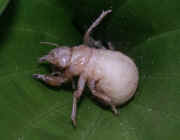
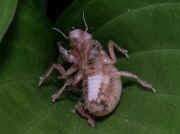
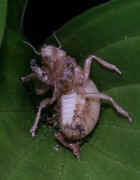
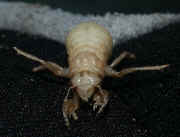
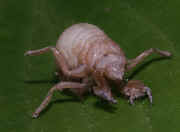 Young Nymph, 5-19-06
Young Nymph, 5-19-06
|
|||
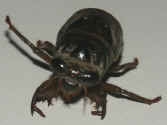
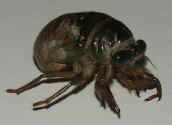
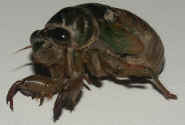
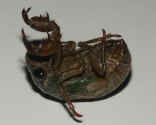
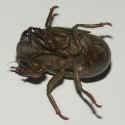 Older Nymph, 7-2-04
Older Nymph, 7-2-04
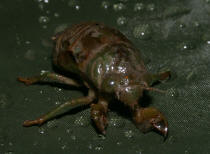
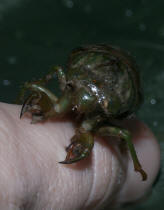
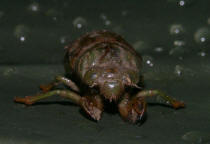
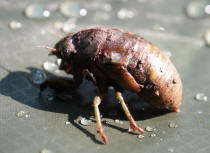
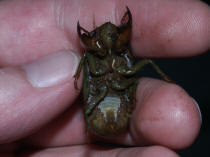 Older Nymph, 7-26-08 (from Nelson, OH)
Older Nymph, 7-26-08 (from Nelson, OH)
Here is an older nymph I found in the "wooded area" at my new house while I was digging a hole to plant some English Ivy on May 14, 2009. Finally, I could take some true macro shots of a nymph. I even scrubbed this guy up with a moist q-tip so you could see the details and facial features. He is photographed on my Vegetanimal Woodburning. I also made a few animations from the still photos.
Here are some normal videos (not still frames pieced together) on Youtube of this same cicada nymph.
Here is an older nymph discovered under the grass (that was being removed to make room for a flower bed) on July 4, 2010. It was photographed in my moss garden. I think this one is almost ready to emerge. Notice the dark eyes it has and the green wings, as compared with the lighter eyes and brown wings above. You can see that they have green wings when they emerge by looking at one splitting through its skin. These photos were taken in my favorite section of moss (two species different than the one above). |
Cicada holes
I photographed these cicada holes in Weatherbee Woods Preserve on April 21, 2021. They were all over the forest floor. It was raining today, and it appears that caps of soil broke off, leaving the exposed hole. I don't normally see the caps. Usually, there are just a lot of large holes in the ground. The cicadas that made the holes I found today were just coming to the surface to breathe due to the rain flooding the ground. They weren't actually ready to emerge.
Splitting through the skin and emerging as an adult cicada
For 23 years, I have wanted to observe a cicada emerging from its shell (ever since I was 8 and first saw the shells). On the evening of July 25th, 2006 at around 11:55pm, I finally got the chance. One had climbed onto the wall by my side door and luckily, Brian noticed it and alerted me to get my camera. I took a lot of photographs of it when it first started to come out of the shell. Once it was pretty much out, I went inside. After seeing its stubby, crunched-up wings, I figured there must be some other stage where its wings would develop more. I assumed I wouldn't get to see this process. Unfortunately, my assumption was wrong---when I went back outside at around 2 am, the cicada was fully emerged, resting next to its skin, and the wings were there! They must have unfolded, which seemed impossible from the looks of things. What a surprise. It's too bad I didn't get any pictures of them unfolding. The cicada still doesn't have the adult coloration---it is a very pale green color, but it seems to be darkening up a bit over time. Below are the photos of its emergence in sequential order. At the end is a close-up of a different split skin.
On July 11, 2015, I got lucky again. On my walk around the neighborhood, I found a nymph crawling on the sidewalk. I knew it had to be looking for a place to latch onto and emerge as an adult. I took it home and put it on the curtains. Unfortunately, I was a bit too late to see the actual emergence, but I took photos just afterward on the curtains, a petunia, and a willow.
Adult Cicadas
I almost captured an incredible moment on August 22, 2011, but I missed it by about 20 seconds. My parents found two cicadas mating while they were out for a walk in the neighborhood---they were actually butt to butt instead of the male on top of the female. Unfortunately, I think my dad accidentally stepped on the male before they found them (or maybe someone else did before my parents arrived) because he was dead when I got him and I could see where his thorax was crushed. However, the pair stayed linked together and my parents saved them for me. I picked them up and drove home, started getting the camera ready. Just when I got the lens and flash on, she flipped over and freed herself from him. So I didn't get any pictures of the mating. I figured before I let her go, I would get a few photos since I had the camera set up already. These are not my best, but they do show a few close-ups of the cicada's features.
On September 16, 2006, Brian found a living adult cicada in the lawn. It seemed to be dying, as it did not try to immediately fly away when I caught it. I managed to take photos of it on several different surfaces---a leaf, two different hasta flowers, and summer poinsettia flowers. Then it flew up high, hit my house, bounced off and headed west. This is the first adult cicada I've ever photographed while it was still alive (besides the one that emerged from a nymph).
The adult pictured below was photographed at dusk on 8-21-05. Unfortunately, it was freshly dead when I found it. If it was alive, I probably wouldn't have gotten any photos of it. Notice how the three red dots near the top of its head act as reflectors.
Here is the same adult photographed on 8-22-05 with daylight (natural settings) and indoor lighting (white background).
Below is a close-up of the head and thorax region, the underside, and a close-up of one of its eyes.
Here is a different cicada specimen that I mounted with its wings out. This way, you can see all four wings.
To learn more about cicadas, click the links below:
Go to Insects, Spiders and Other Tiny Creatures Main Page
[ Cicadas ] [ Periodical Cicadas] [ Leaf-hoppers ] [ Ant Lions ] [ Ants ] [ Grasshoppers and Crickets ]
[ Katydids ] [ Weevils ] [ Bumblebees and Carpenter Bees ] [ Honeybees ] [ Wasps ] [ Flies and Other Flying Insects ]
[ Beetles and Other Insects ] [ Praying Mantises ] [ Damselflies and Dragonflies ] [ Centipedes and Millipedes ]
[ Moths ] [ Pandora Sphinx Moth ] [ 5-Spotted Hawk Moth ] [ Polyphemus Moth ]
[ Butterflies ] [ Monarchs ] [ Black Swallowtail ] [ Skippers ]
[ Jumping Spiders Volume 1 ] [ Phidippus Jumping Spiders Volume 2 ] [ Phidippus Jumping Spiders Volume 3 ] [ Baby Phidippus Jumpers ]
[ Biglegs the Jumping Spider ] [ Tufts & Mr. Greenfangs ] [ Phidippus clarus Jumping Spiders]
[ "Radinka Onawa" and other Platycryptus undatus jumping spiders ] [ Platycryptus undatus jumping spiders 2012 - present ] [ Platycryptus Babies ]
[ Zebra Spiders ] [ Miscellaneous Jumping Spiders ]
[ Orb-Weavers Volume 1 ] [ Orb-Weavers Volume 2 ] [ Baby Orb-weavers ]
[ Crab Spiders ] [ Miscellaneous Spiders ] [ Spider Webs ]
[ Home ] [ Artwork ] [ Photography ] [ Art Cars ] [ Virtual Museum ] [ Pets ] [ Favorite Links ] [ What's New / My Blog ] [ Guestbook ] [ For Sale ]
Copyright © 2004-2024 kozmicdreams.com. All rights reserved.
All materials contained on this site, including text, graphics and icons, are the property of
kozmicdreams.com.